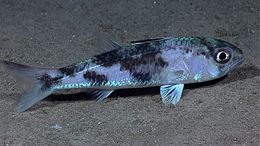Acropomatidae
| Acropomatidae Temporal range: 55.5–0 Ma Early Eocene to Present |
|
|---|---|
 |
|
| Synagrops bellus | |
| Scientific classification | |
| Kingdom: | Animalia |
| Phylum: | Chordata |
| Class: | Actinopterygii |
| Order: | Perciformes |
| Superfamily: | Percoidea |
| Family: |
Acropomatidae T. N. Gill, 1893 |
| Genera | |
|
Acropoma Temminck & Schlegel, 1843 |
|
Acropoma Temminck & Schlegel, 1843
Doederleinia Steindachner, 1883
Malakichthys Döderlein, 1883
Synagrops Günther, 1887
Verilus Poey, 1860
Acropomatidae is a family of fish in the order Perciformes, commonly known as lanternbellies. Acropoma species are notable for having light-emitting organs along their undersides. They are found in all temperate and tropical oceans, usually at depths of several hundred meters.
Members of the family are generally small, with some ranging up to 40 cm, but most no more than 15 cm. They have two dorsal fins, the first with seven to 10 spines and the second with possibly a spine in addition to eight to 10 soft rays. The anal fin has two or three spines, and the pelvic fins one spine and five soft rays.
...
Wikipedia
